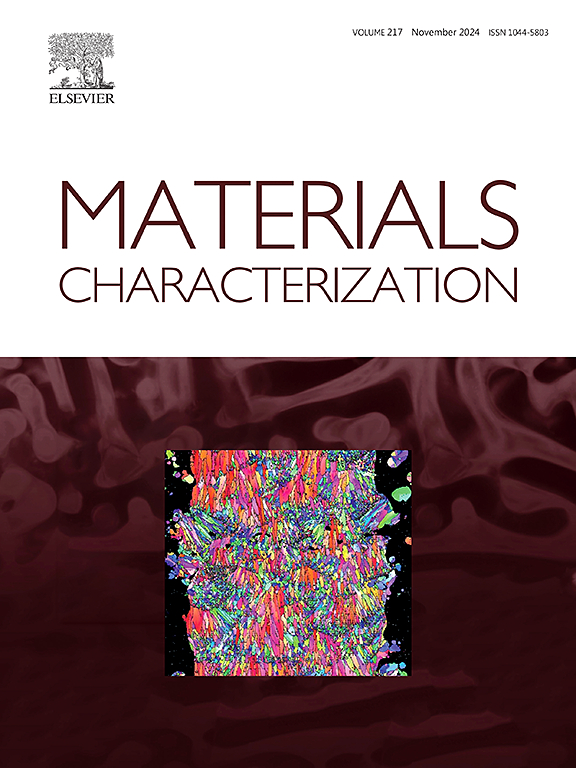Difference in hydrogen trapping behaviors between epsilon carbide and cementite in steels
IF 4.8
2区 材料科学
Q1 MATERIALS SCIENCE, CHARACTERIZATION & TESTING
引用次数: 0
Abstract
The hydrogen trapping sites associated with epsilon carbide (ε-carbide) and cementite precipitates in high‑silicon martensitic steels tempered at different temperatures were investigated by direct observation using atom probe tomography (APT) combined with a deuterium charging method. Charged deuterium was obviously trapped within film-like ε-carbide precipitates in steel tempered at 400 °C. In contrast, no charged deuterium was observed in fine spheroidal cementite precipitates in steel tempered at 500 °C. However, in undeformed pearlitic steel, deuterium was weakly segregated at/near the lamellar cementite/ferrite interface. First-principles calculations have predicted that both ε-carbide and cementite have stable sites for hydrogen within their carbides, but diffusion barriers for hydrogen are too high to reach these sites. APT analysis indicated that the undeformed cementite (Fe3C) has a stoichiometric carbon composition of 25 at. % without carbon vacancies, whereas ε-carbide has much lower carbon concentrations than the stoichiometric composition (Fe2C), indicating high concentrations of carbon vacancies in ε-carbide. The high concentrations of carbon vacancies increased stable sites in ε-carbide and facilitated hydrogen diffusion by providing low-barrier diffusion pathways, enhancing its hydrogen-trapping ability. The difference in hydrogen trapping behavior between the two carbides is therefore attributed to the presence or absence of low-barrier diffusion pathways in the carbides, driven by the high concentrations of carbon vacancies.
钢中ε碳化物和雪明碳化物的氢捕获行为差异
通过原子探针层析成像(APT)直接观察结合氘充电法,研究了在不同温度下回火的高硅马氏体钢中与ε-碳化物(ε-carbide)和雪明碳化物沉淀相关的氢捕获位点。在 400 °C 回火的钢中,带电氘被明显地截留在薄膜状的ε-碳化物沉淀中。相反,在 500 °C 回火的钢中,细小的球状雪明碳化物沉淀中未观察到带电氘。不过,在未变形的珠光体钢中,氘在片状雪明碳化物/铁素体界面处或附近有弱偏析。第一性原理计算预测,ε-碳化物和雪明碳酸盐在其碳化物中都有氢的稳定位点,但氢的扩散障碍太高,无法到达这些位点。APT 分析表明,未变形的雪明碳化物(Fe3C)的化学计量碳成分为 25%,不含碳空位,而ε-碳化物的碳浓度远低于化学计量碳成分(Fe2C),表明ε-碳化物中存在高浓度的碳空位。高浓度的碳空位增加了ε-碳化物中的稳定位点,并通过提供低阻扩散途径促进了氢扩散,从而提高了其捕氢能力。因此,两种碳化物在捕氢行为上的差异可归因于碳化物中是否存在由高浓度碳空位驱动的低势垒扩散途径。
本文章由计算机程序翻译,如有差异,请以英文原文为准。
求助全文
约1分钟内获得全文
求助全文
来源期刊

Materials Characterization
工程技术-材料科学:表征与测试
CiteScore
7.60
自引率
8.50%
发文量
746
审稿时长
36 days
期刊介绍:
Materials Characterization features original articles and state-of-the-art reviews on theoretical and practical aspects of the structure and behaviour of materials.
The Journal focuses on all characterization techniques, including all forms of microscopy (light, electron, acoustic, etc.,) and analysis (especially microanalysis and surface analytical techniques). Developments in both this wide range of techniques and their application to the quantification of the microstructure of materials are essential facets of the Journal.
The Journal provides the Materials Scientist/Engineer with up-to-date information on many types of materials with an underlying theme of explaining the behavior of materials using novel approaches. Materials covered by the journal include:
Metals & Alloys
Ceramics
Nanomaterials
Biomedical materials
Optical materials
Composites
Natural Materials.
 求助内容:
求助内容: 应助结果提醒方式:
应助结果提醒方式:


